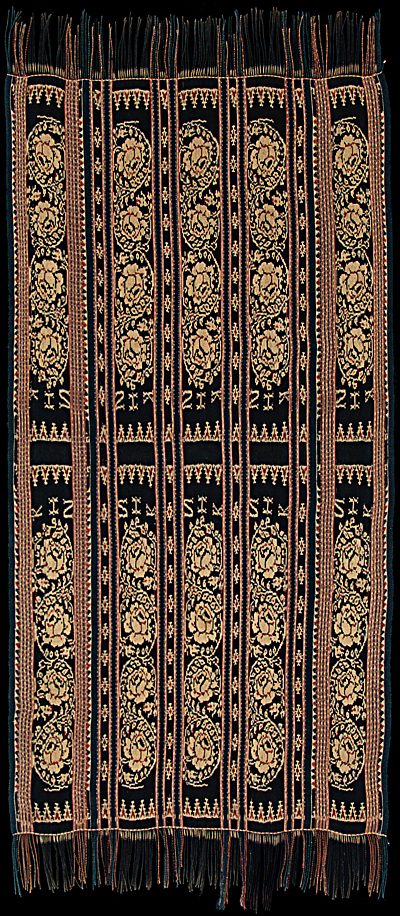| |
 
 | | | |
295 Savu Group, Savu
Hi'i (men's shawl)  
| | | Period: | Late colonial | | Yarn: | Cotton, hand-spun, extremely fine, double-ply | | Technique: | Warp ikat | | Panels: | 1 | | Size: | 77.5 x 157 cm (2' 6" x 5' 1") LW: 2.03 | | Weight: | 410 g (14.5 oz), 337 g/m2 (1.10 oz/ft2) | | Design: | Field decorated with five black bands carrying ecru flower motifs, probably camelia, of European inspiration - the needlework patterns distributed to weavers by the church, to wean them off motifs of deeper significance, such as veneration of the ancestors, respect for descent lines. Many Christian Savunese weavers relished these patterns and created little masterworks on the basis of them. Such cloths might grace a man's shoulders on the market place, but could play no role in ceremonies conducted following the rules of Jingi Tiu, the old animist religion. | | Comment: | [PHOTOGRAPHY PROVISIONAL] Weaving of the same class as PC 030. Also stylistically similar, but here with a flourish, an éclat, that in many eyes would make it superior. The weaver appears to have signed the cloth with the initials KHN, presumably her own. Use of lettering is a status marker, even on Savu, where literacy came early. Twisted fringes. | | Background: | Chapters on Savu Group and Savu. | | Compare: | 030 087 | | Sources: | Very similar example in Museum Tekstil, Jakarta, with three wide ikated bands rather than five, interspersed with with two narrower bands, also with floral decorations; depicted in Duggan, Woven Stories, p. 100. Similar to example in National Gallery of Australia, Acc. Nr. 277.2000, which has narrower main ikated bands and wider secondary bands. Hi'i of similar style and sophistication in Khan-Majlis, Indonesische Textilien, Fig. 441. Another is in Duggan, Ikats of Savu, Fig. 93. | | |

©Peter ten Hoopen, 2025
All rights reserved.
|
|


